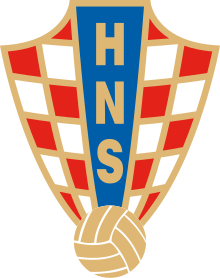Soccer in Croatia
Football was played in Croatia by English workers in the port city of Rijeka as early as 1873 . The first official meeting was organized by English sailors in Zadar . In the period that followed, more and more Croatian youths began to play football under the guidance of the English .
The first rules in Croatian were published in Zagreb in 1896 , and the first club to have the word soccer in its name was the First Soccer and Sports Club in Zagreb (abbreviation PNIŠK in Croatian ).
The first major international successes were the finals of Dinamo Zagreb in the Exhibition Cities Cup in 1963 and 1967.

The Croatian Football Association has existed since 1912.
National leagues
1. HNL
The first Croatian football league ( 1. HNL ) was formed after the independence of the state of Croatia in 1991. Before that, during the Second World War from 1941–1945 there was an independent league with purely Croatian clubs. After this time, the Croatian clubs played in the Yugoslav league. By the end of the 1980s, the Hajduk Split and Dinamo Zagreb clubs had notable international successes.
In the 1994/95 season Hajduk Split reached the quarter-finals of the Champions League , Dinamo Zagreb qualified for the group stage of the Champions League in 1998/99, 1999/00 and 2011/2012.
The current weakness of Croatian clubs is based on several causes. The relatively low number of spectators with a total population of 4.5 million people means that there is comparatively little income from ticket sales and sponsorships.
Dinamo Zagreb has dominated the national league since 1991 and mostly plays the championship against Hajduk Split , and in recent years increasingly against Rijeka .
Therefore the clubs from Croatia are currently not internationally competitive. Many of the best Croatian football players play in the German Bundesliga , in Spain and in Italy . Since the 2013/14 season, the 1st HNL has consisted of ten clubs.
2. HNL
The game system was also changed frequently in the second division.
Since the 2006/07 season there has been a single-track second division, which has consisted of 12 clubs since the 2012/13 season. The top three will go straight to the top division. The four last-placed teams are replaced by the champions of the three seasons of the third division and a runner-up of these seasons, who is determined by relegation games. In the games of the second division, there must be at least two players on the starting line-up who are no more than 22 years old. A maximum of four foreigners may be used per game.
3. HNL
Since the 2016/17 season, 16 or 18 teams have played a total of two promoted teams in the second division in three seasons. The last two teams of each season are relegated. In the games of the third division, there must be at least three players on the starting line-up who are no more than 22 years old.
Overview of the league system
The following league system has been in place since the 2006/17 season :
- Highest class:
- 1. HNL (10 teams)
- Second highest class:
- 2. HNL (12 teams)
- Third highest class:
- 3. HNL Ost (16 teams)
- 3. HNL West (16 teams)
- 3. HNL South (18 teams)
Licensing terms
In 2006 the license conditions for the Croatian leagues were significantly tightened by the association by adapting them to the UEFA regulations and recommendations.
The currently applicable points include:
- Stadium equipment
- Minimum audience capacity
1st division: 5,000 seats, of which min. 3,000 seats, of which min. 1,000 covered
2nd division: 3,000 seats, of which min. 1,000 seats, of which min. 300 covered
3rd division: 1,000 seats, of which min. 100 covered seats - Floodlight
system illuminance min. 1 200 lx in the 1st division, recommended in the 2nd division - Electronic scoreboard in the 1st division
- Flagpoles
- Field size
- Promotion of youth football
- Infrastructure and qualified staff
- Number of teams and players in official competitions of the association
1st division: 5 teams and 120 players
2nd division: 5 teams and 100 players
3rd division: 4 teams and 80 players
- Minimum audience capacity
- Promotion of women's football
National team
The Croatian national team is considered to be the strongest of the successor states of the former Yugoslavia , ahead of the national teams of Serbia and Slovenia .
Croatia hosted the European Football Championship in 1976 (as part of Yugoslavia).
See also
Web links
- Association of the first division clubs of Croatia ( Memento from August 16, 2009 in the Internet Archive )
Individual evidence
- ^ History according to the official homepage (Croatian) , accessed on March 19, 2009
- ↑ PROPOZICIJE NATJECANJA ZA PRVENSTVO DRUGE HRVATSKE NOGOMETNE LIGE ZA NATJECATELJSKU 2009/2010. GODINU ( page no longer available , search in web archives ) Info: The link was automatically marked as defective. Please check the link according to the instructions and then remove this notice. (Croat.)
- ↑ PROPOZICIJE NATJECANJA ZA PRVENSTVO TREĆE HRVATSKE NOGOMETNE LIGE ZA NATJECATELJSKU 2009/2010. GODINU ( page no longer available , search in web archives ) Info: The link was automatically marked as defective. Please check the link according to the instructions and then remove this notice. (Croat.)
- ↑ Licensing conditions ( Croat .) From the official homepage of the Croatian Association, accessed on September 1, 2009



